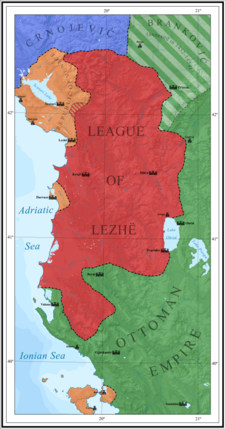Albania in the Middle Ages
After a war against the Byzantine empire led the kingdom occasionally decrease in size until the Angevins eventually lost their rule in Albania and led the territory ruled by several different Albanian chieftains until the mid 14th century which for a short period of time were conquered by the short-lived empire of Serbia.In 1444, Gjergj Kastrioti Skanderbeg was proclaimed as the leader of the regional Albanian chieftains and nobles united against the Ottoman Empire in the League of Lezhë disestablished in 1479.It consists of settlements usually built below hillforts along the Lezhë (Praevalitana)-Dardania and Via Egnatia road networks which connected the Adriatic coastline with the central Balkan Roman provinces.The population of Komani-Kruja represents a local, western Balkan people which was linked to the Roman Justinianic military system of forts.The development of Komani-Kruja is significant for the study of the transition between the classical antiquity population of Albania to the medieval Albanians who were attested in historical records in the 11th century.Participation in trade networks of the eastern Mediterranean via sea routes seems to have been very limited even in nearby coastal territory in this era.In later Byzantine usage, the terms Arbanitai and Albanoi, with a range of variants, were used interchangeably, while sometimes the same groups were also called by the classicising name Illyrians.[13] The area, known as Kutmichevitsa, became an important Bulgarian cultural center in the 10th century with many thriving towns such as Devol, Glavinitsa (Ballsh) and Belgrad (Berat).In 1204, after Western crusaders sacked Constantinople, Venice won nominal control over Albania and the Epirus region of northern Greece and took possession of Durrës.A prince from the overthrown Byzantine ruling family, Michael Comnenus, made alliances with Albanian chiefs and drove the Venetians from lands that now make up southern Albania and northern Greece, and in 1204 he set up an independent principality, the Despotate of Epirus, with Ioannina in northwest Greece) as its capital.Throughout its existence, the principality was an autonomous dependency of its neighbouring powers, first Byzantium and, after the Fourth Crusade, Epirus, while it also maintained close relations with Serbia.The kingdom extended from Durazzo (modern Durrës) south along the coast to Cape Linguetta, with vaguely defined borders in the interior.After the fall of the Principality of Arber in territories captured by the Despotate of Epirus, the Kingdom of Albania was established by Charles of Anjou.Charles signed a treaty with them and was proclaimed King of Albania "by common consent of the bishops, counts, barons, soldiers and citizens" promising to protect them and to honor the privileges they had from Byzantine Empire.This alarmed the Byzantine Emperor, Michael VIII Palaiologos, who began sending letters to local Albanian nobles, trying to convince them to stop their support for Charles of Anjou and to switch sides.During its existence Catholicism saw rapid spread among the population which affected the society as well as the architecture of the Kingdom.A Western type of feudalism was introduced and it replaced the Byzantine Pronoia.Naturally, it required a collective budget for covering the military expenditures; each family contributed their mite to the common funds of the League.Threatened by Ottoman advances in their homeland, Hungary, and later Naples and Venice, their former enemies, provided the financial backbone and support for Skanderbeg's army.On 14 May 1450, an Ottoman army, larger than any previous force encountered by Skanderbeg or his men, stormed and overwhelmed the castle of the city of Krujë.In June 1446, Mehmed II, known as "the conqueror", led an army of 150,000 soldiers back to Krujë, but failed to capture the castle.Foreign commerce flourished to such an extent that leading Albanian merchants had their own agencies in Venice, Ragusa (modern Dubrovnik, Croatia), and Thessalonica (now Thessaloniki, Greece).





History of AlbaniaOrigin of the AlbaniansIllyriaIllyriansMacedoniaIllyricumByzantine ruleBulgarian rulePrincipality of ArbanonAngevin Kingdom of AlbaniaPrincipality of AlbaniaSerbian rulePrincipalitiesLeague of LezhëVenetian AlbaniaPrincipality of MirditaOttoman AlbaniaIslamization of AlbaniaSanjak of AlbaniaSanjak of ScutariSanjak of DibraScutari VilayetJanina VilayetManastir VilayetKosovo VilayetPashaliksMassacre of the beysNational AwakeningRevolts of 1833–1839Revolt of 1843–1844Revolt of 1845Revolt of 1847League of PrizrenLeague of PejaRevolt of 1910Revolt of 1911Battle of DeçiqRevolt of 1912Albanian VilayetDeclaration of IndependenceIndependent AlbaniaProvisional GovernmentCongress of TriesteInternational Commission of ControlBalkan WarsPrincipalityPeasant RevoltWorld War I in AlbaniaRepublic of Central AlbaniaRepublic of KorçëRepublic of MirditaItalian protectorate (southern)Congress of DurrësVlora WarCongress of LushnjëItalian protectoratePrincipality (Regency)Albanian RepublicAlbanian KingdomAlbania under ItalyGerman occupation of AlbaniaWorld War II in AlbaniaSecond League of PrizrenLiberation DaySocialist AlbaniaPost-communism1997 Albanian civil unrestRepublic of AlbaniaConstitutionEconomyMonarchsMilitaryTimelineAlbanian noblemenByzantine empireBattle of SavraOttomanrevoltSkanderbegBattle of NišCrusade of VarnaGjergj Kastrioti SkanderbegAlbanian chieftains and noblesKomani-Kruja cultureNorth MacedoniaLezhëPraevalitanaDardaniaVia Egnatiatype siteclassical antiquityOrigin of AlbaniansAlbania under Byzantine EmpireEpirus NovaRoman EmpireVisigothsOstrogothsAlbanoiGheg AlbanianArbëreshëGermanic GothsBalkan PeninsulaByzantineAlbania under the Bulgarian EmpireFirst Bulgarian EmpirePresianKutmichevitsaBallshDurrësmajor Bulgarian uprisinganother uprisingGeorgi VoitehSecond Bulgarian EmpireIvan Asen IIAlbania under Serbian EmpireDespotate of EpirosConstantinopleEpirusMichael ComnenusDespotate of EpirusIoanninaNaplesCharles I of AnjouStefan DusanFourth CrusadeSerbia